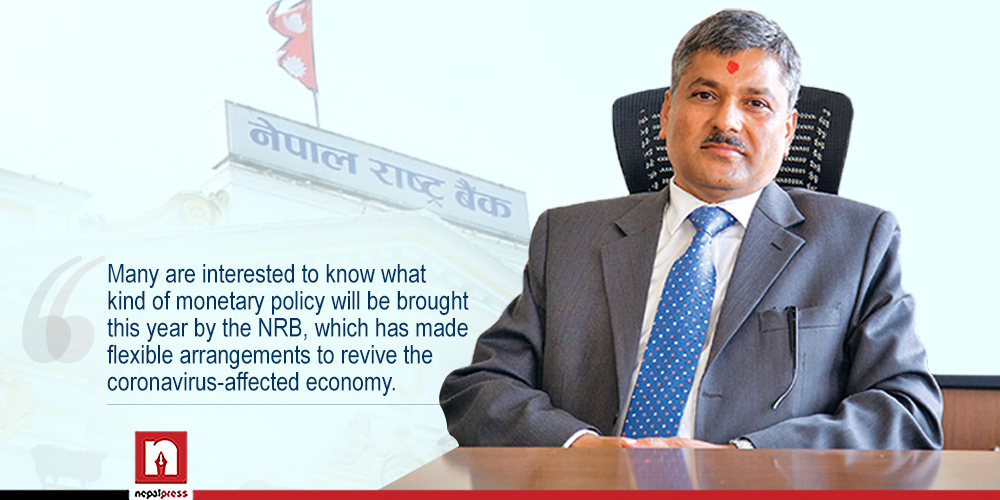Upcoming Monetary Policy discussion: Experts say credit policy needs to change

KATHMANDU: Nepal Rastra Bank is busy preparing the monetary policy for the coming Fiscal Year 2078/79. At a time when coronavirus is heavily affecting the country’s private sector, industrialists and bankers are waiting to see what programs the monetary policy will bring.
NRB makes public the monetary policy in the third week of July every year. The monetary policy of the current Fiscal Year had made arrangements for interest rate exemption and refinancing of loans. Many are interested to know what kind of monetary policy will be brought this year by the NRB, which has made flexible arrangements to revive the coronavirus-affected economy.
Economists have analyzed that it has become easier to maintain financial stability in Nepal’s economy due to the flexible monetary policy brought by Nepal Rastra Bank in the current fiscal year. However, due to different challenges and problems in the coming fiscal year as compared to last year, it is also being analyzed that liquidity management is not going to be as convenient as in the current fiscal year.
Governor of Nepal Rastra Bank Maha Prasad Adhikari has been saying in various interactions that interest rate rebates and concessions should not be sought through the upcoming monetary policy. He argues that since the principles of economics do not work in Nepal’s economy, one should not always seek discounts and concessions to control the money supply and work for price stability.
Probable direction of the upcoming monetary policy
Experts have emphasized that the monetary policy of the coming fiscal year should be focused on financial stability and the development of the financial sector. Even though there are around 30 million depositors in Nepal’s banks and financial institutions, only about 3% of the population seems to have access to credit. People who want to opt for entrepreneurship have been complaining that they are deprived of loans as loans are provided after valuing fixed assets only.
Experts say that if loans are provided only on the basis of real estate valuation, there will be problems in maintaining the stability of the economy due to the formation of ‘asset bubbles’. Experts have stressed the need to change the policy as it will deprive the poor people of loans and make the rich richer. He is of the view that business lending should be encouraged rather than lending based on collateral.
Increased pressure will be put on banks and financial institutions to manage the growing demand for credit this year. Debt growth has been 23% in the current fiscal year. Banks and financial institutions will face the challenge of managing the loan demand of Rs. 800 billion. To do this, the central bank has to come up with a different kind of monetary policy than last year.
Financial analyst Anil Raj Bhattarai said that the upcoming monetary policy should focus on financial sector stability, instrument operation, and liquidity pressure management. He said that instead of the CCD ratio, the liquidity ratio should be managed, the policy rate should be removed and the credit provisioning system should be relaxed and made more flexible.
“If we move forward by maintaining the liquidity ratio at 15% instead of the CCD ratio, there will be a liquidity of Rs 150 billion in the banking and financial sector,” he said.
Bhattarai also said that the policy rate provided by the central bank has not been implemented effectively.
“The 5% policy rate has not been able to effectively represent the market. Its effectiveness is not seen anywhere in the credit rate, bond market, loans, or deposits,” he said.
Bhattarai also stressed on the need to change the pricing policy of loans and property liabilities given by banks and financial institutions. He says the policy rate is controlled by the spread rate and the base rate, so it cannot represent the rate of the market. He says the central bank should make policy arrangements on how to make this more effective.
“If the liquidity ratio is maintained at 15%, fluctuations in the CCD ratio and the CRR rate will not have a big impact,” says Bhattarai.
In order to make the implementation of the interest rate corridor more effective, the central bank has the facility to change the CCD ratio and the mandatory cash reserves.
He suggested reducing the rate of mandatory cash reserve SLR. Even if this ratio helps the government to raise loans, it is not advisable for the government to always rely on banks and financial institutions for public loans. Now the government can also raise money through insurance companies. In addition, the bond market can be made effective. Experts say the government could raise money from investors if the bond market is to be strengthened.
He also stressed the need to reduce the loan provisioning period. He says there is a need to change the system of paying off debts and paying interest. If the debtor fails to repay the loan for 1 month, 3 months, and 6 months, there is a provision to book a bad loan.
Experts say that the system of bad loans should be relaxed as even honest and sincere debtors could not repay the loan during the time of COVID. Entrepreneurs in the tourism, hotel, grocery, and airlines sectors are not in a position to repay loans even if they want to.
Banking and financial profits will increase if the provision for bad loan provisioning is relaxed. Discouraging the distribution of cash dividends on the profits of banks increases the capacity of banks and financial institutions.
Banks have raised all loans in Nepal as they are assessed on the basis of real estate property ownership. When valuing land, loans are provided by calculating the market price and the average government price. As the loan will be given at an average of 60% of the value of the land, it is estimated that the banks and financial institutions will remain in profit.
Executive Director of the Research Department of Nepal Rastra Bank Dr. Prakash Kumar Shrestha says that theoretical measures will be taken to strike a balance between the budget brought by the government and the demand for loans in the economy. He said the forthcoming monetary policy should focus on COVID-19, the budget, economic recovery, and financial stability.
He said that the monetary policy will pay more attention to the current price demand as there exists convenient availability of loans and interest rate stability.
“The central bank needs to find the necessary monetary instruments to maintain liquidity management, easy availability of credit, and interest rate stability,” he said.
President of the Federation of Nepalese Chambers of Commerce and Industry Shekhar Golchha said that stability in interest rates, refinancing and rescheduling were their main demands.
“The federation is preparing suggestions for the upcoming monetary policy. However, our focus is on single-digit interest rates, liquidity management, concessional loans, and rescheduling of loans and payment,” he said.















